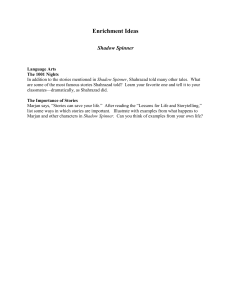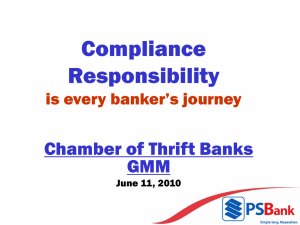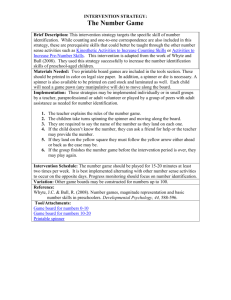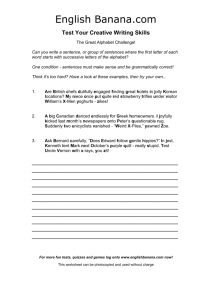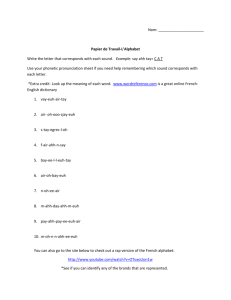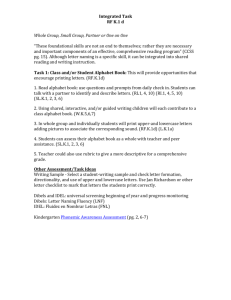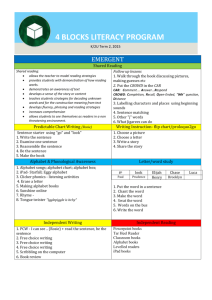10 Cool Things I Learned while Writing Alphabet of
advertisement
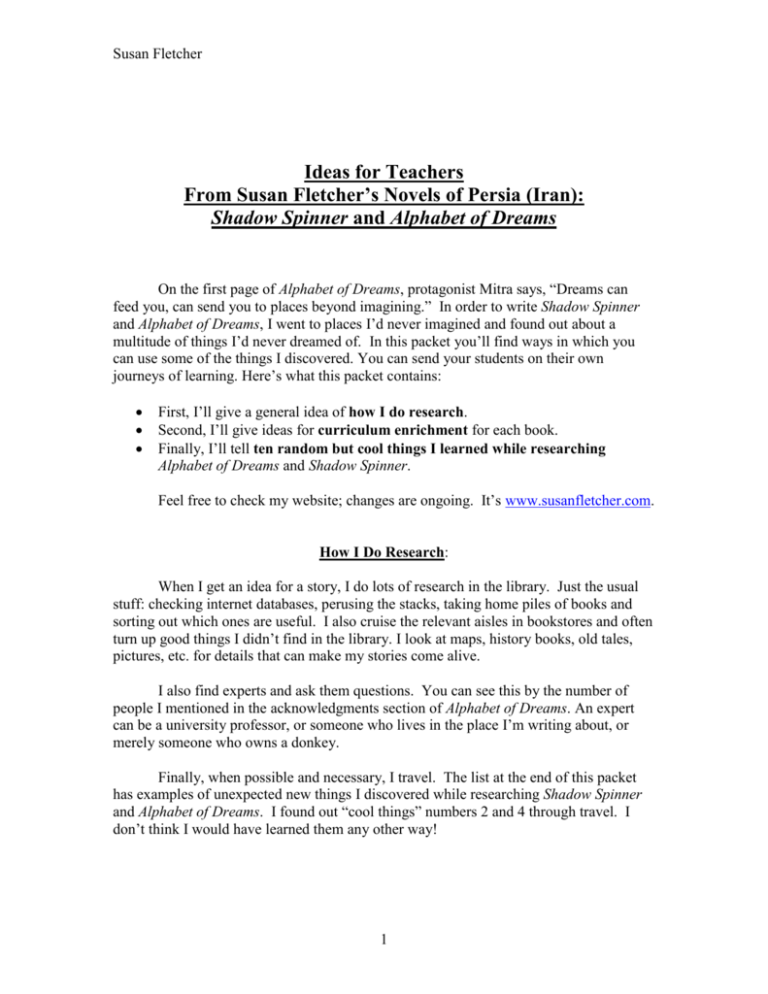
Susan Fletcher Ideas for Teachers From Susan Fletcher’s Novels of Persia (Iran): Shadow Spinner and Alphabet of Dreams On the first page of Alphabet of Dreams, protagonist Mitra says, “Dreams can feed you, can send you to places beyond imagining.” In order to write Shadow Spinner and Alphabet of Dreams, I went to places I’d never imagined and found out about a multitude of things I’d never dreamed of. In this packet you’ll find ways in which you can use some of the things I discovered. You can send your students on their own journeys of learning. Here’s what this packet contains: First, I’ll give a general idea of how I do research. Second, I’ll give ideas for curriculum enrichment for each book. Finally, I’ll tell ten random but cool things I learned while researching Alphabet of Dreams and Shadow Spinner. Feel free to check my website; changes are ongoing. It’s www.susanfletcher.com. How I Do Research: When I get an idea for a story, I do lots of research in the library. Just the usual stuff: checking internet databases, perusing the stacks, taking home piles of books and sorting out which ones are useful. I also cruise the relevant aisles in bookstores and often turn up good things I didn’t find in the library. I look at maps, history books, old tales, pictures, etc. for details that can make my stories come alive. I also find experts and ask them questions. You can see this by the number of people I mentioned in the acknowledgments section of Alphabet of Dreams. An expert can be a university professor, or someone who lives in the place I’m writing about, or merely someone who owns a donkey. Finally, when possible and necessary, I travel. The list at the end of this packet has examples of unexpected new things I discovered while researching Shadow Spinner and Alphabet of Dreams. I found out “cool things” numbers 2 and 4 through travel. I don’t think I would have learned them any other way! 1 Susan Fletcher Enrichment Ideas Shadow Spinner Social Studies—Messenger Pigeons Zaynab sends messages by means of pigeons. How do people train pigeons to carry messages? How are the messages attached? Nowadays, many people race pigeons. How do the pigeons know where to go? To find out about an organization of people who race homing pigeons, check out the American Racing Pigeon Union at www.pigeon.org. (Possibly a member of this organization might be willing to visit your classroom.) Messenger pigeons were also used extensively in World War I. Some messenger pigeons were decorated for valor in World War II. Tell how and why they were used. What other means of long-distance communication were used in the ancient world? Language Arts—The 1001 Nights In addition to the stories mentioned in Shadow Spinner, Shahrazad told many other tales. What are some of the most famous stories Shahrazad told? Learn your favorite one and tell it to your classmates—dramatically, as Shahrazad did. Language Arts—the Importance of Stories Marjan says, “Stories can save your life.” After reading the “Lessons for Life and Storytelling,” list some ways in which stories are important. Illustrate with examples from what happens to Marjan and other characters in Shadow Spinner. Can you think of examples from your own life? Social Studies/Technology—Ancient Baths Mitra is taken directly to the baths upon entering the harem. Find out more about old Middle Eastern baths. How do they differ from old Roman baths? What technologies are necessary to create them? There are many fountains in Shadow Spinner, yet there were no electric pumps at the time. How did the fountains work? 2 Susan Fletcher History/Religion--Islam The people in Shadow Spinner are of the Islamic faith. Who originated this religion? When? Who are the “people of the book”? What is the Muslim holy book? What are the “Five Pillars of Islam?” What is a moazzen? Social Studies--Sharbat Zaynab serves Mitra sharbat. What is sharbat? How is it made? Make some sharbat and see how it tastes. Can you find out how, in the ancient Middle East, people could have ice in their sharbat? Social Studies—Rooftop Living Zaynab lives on the roof of a palace. Many people in the Middle East use roofs as living spaces. Can you find pictures of what some of these roof living spaces look like? Why, in the Middle East, are the roofs usually flat rather than angled? Why might people like to spend time on their roofs? Social Studies—the Bazaar Mitra looks for the storyteller in the bazaar. In many Middle Eastern countries, the bazaar is the equivalent of our shopping mall. Find out about Middle Eastern bazaars. What do they look like? What kinds of goods are sold there? What kinds of containers is the merchandise displayed in? Taken home in? Are prices set or do customers bargain? You could have a bazaar day (“It’s Bazaar!”) in your classroom, in which students bring merchandise (limits set by you!), set up booths, and bargain with their classmates, perhaps with scrip. 3 Susan Fletcher Enrichment Ideas Alphabet of Dreams Geography—the Ancient and Modern Middle East There is a map of the territory of the novel at the start of Alphabet of Dreams. Through what modern countries do Mitra and her companions travel? What cities have the same names today as they had during the time of the novel? What cities have different names today? Students might plot the journey on a map of today’s Middle East. Science/Zoology--Camels There are a couple of different kinds of camels in Alphabet of Dreams. What is the difference between one-humped camels (dromedaries) and two-humped camels (Bactrian camels)? What are the ways in which camels’ bodies are specifically adapted for their environments? Can you think of other animals specifically adapted for particular environments? Social Studies/History—Camel Gear Mitra is given the job of mending camel gear. What are some kinds of gear and decoration that camels might wear? What is the function of the various types of gear? What is a nose peg, and what is it for? There are many different kinds of saddles for dromedaries. Find out about Tuareg saddles, Kenyan saddles, Arabian saddles, and Omani saddles. In what way are Omani saddles significantly different from the others? (Hint for teachers: For Omani saddles, see Bedouin: Nomads of the Desert, by Alan Keohane, pp 90-91.) Where is the saddle usually put on a Bactrian (two-humped) camel? How does a saddle for a camel differ from a saddle for a horse? What other means of transportation were used in the ancient world? Advanced—see Richard Bulliet’s The Camel and The Wheel: Some countries used the wheel for a long time, then discarded the wheel and began to use camels instead. Where did this happen? When? Why? 4 Susan Fletcher History of Technology/Science—Astronomy/Astrolabe Learn how to use an astrolabe (the Magi’s “star-catcher”) to tell time at night. You can find out how to buy and use an astrolabe customized to the date and geographical location you prefer at: http://astrolabes.org/personal.htm. If you want to teach students how to make their own astrolabes, go to: http://cse.ssl.berkeley.edu/AtHomeAstronomy/activity_07.html. For more information on astrolabes, go to http://astrolabes.org. Social Studies—Frankincense and Myrrh The Magi take gold, frankincense, and myrrh to Bethlehem. What is frankincense? What is myrrh? What are they made of? What part of the world do they come from? Why were they valuable to ancient peoples? You can actually buy frankincense and myrrh today. (Hint for teachers: one place to look is http://science.howstuffworks.com/question283.htm) History/Social Studies--Famous Ancient Gates Mitra and companions go through the Ishtar Gate in Babylon. Find a picture of this famous gate. When was it built? The gate has been reconstructed out of ancient, glazed bricks; where can this reconstruction be found? We are not told which gate the Magi go through to Jerusalem. What are some of the famous gates of that city now? Can you draw the walls of Jerusalem and put in the various gates? Can you find a design of the gates of Jerusalem in Biblical times? Why were ancient cities surrounded by walls? Why don’t modern cities have them? (Hint for teachers: It has to do with the invention and use of gunpowder.) History of Technology—Qanats and Water Transport Mitra follows Babak down into a qanat. What is a qanat? What purpose does it serve? Why must the water run underground? Are there still qanats today? How is a qanat constructed and how does it “work”? Make a diagram. What device is used to get water up out of a shaft of a qanat? (Hint for teachers: For a great video of someone walking inside a qanat, see The Silk Road II series produced by Central Park Media, volume 2: “In Search of Wisdom,” episode 5: “The Scorching Sun and the Southern Road of Iran.” There are camels and bazaars in the Silk Road series, too.) While the ancient Persians were using qanats, the Romans were using aqueducts. Compare and contrast the qanat with the aqueduct. Why would the two countries develop different ways of transporting water? Where does your household tap water come from? How does it get there? 5 Susan Fletcher 10 Random but Cool Things I Learned while Writing Alphabet of Dreams and Shadow Spinner: 1. The difference between one-humped and two-humped camels: One-humped camels are called dromedaries, and they are found mostly in warm, desert lands. Two-humped camels are called Bactrian camels. They do better in cold and mountainous places than dromedaries. In ancient Persia people used Bactrian camels earlier in their history and dromedaries later; I saw carvings of both when I went there. During the Parthian period, people experimented with cross-breeding dromedaries and Bactrian camels, producing camels larger and stronger than either of their parents. How many humps in the cross breed? They had either a single, longish hump, or a single, longish hump with a sort of indentation in it. For huge amounts of information on the camel’s place in history, see The Camel and the Wheel, by Richard W. Bulliet. 2. An ancient security alarm system for caravanserais: First of all, a caravanserai (or caravansary) was a type of inn for people who were traveling with animals. The inn and its high, thick, mudbrick walls surrounded a large square courtyard, where people and animals rested. If you had lots of money, you could book a room in the inn. One of the major functions of caravanserais was to protect the travelers from thieves. The builders of the caravanserais put small holes in the walls, holes that penetrated all the way through. They knew that pigeons would find these niches irresistible as nesting sites. So if thieves tried to scale the walls from the outside, the nesting birds would get alarmed and start cooing like crazy, giving the residents time to prepare for intruders. 3. The origin of the term “parting shot”: Persians during the Parthian era (the period in which Alphabet of Dreams takes place) were well known for their skill at horsemanship, and also with their skill with bow and arrow. One maneuver for which they became famous was to ride away from the enemy, seeming to be in retreat. Then they would twist backward on the horse, and loose a surprise arrow. Ouch! This became known as the “Parthian shot,” and later, presumably, evolved into our term, “parting shot.” 4. Why some Iranian homes have two different kinds of door knockers: In the ancient village of Abyaneh, known for its intricately carved doors, I noticed that the entrances to some houses had double doors with a different kind of knocker on each one. One type of knocker was shaped as a circle. The other was shaped as a straight line. Here’s why: In Iran and some other Muslim countries, it’s considered inappropriate for a man who is not a family member to see a woman who is not modestly 6 Susan Fletcher dressed. However, within the privacy of her home and family, a woman may dress as she likes. And it’s also okay for women outside the family to see one another in less-modest attire. I can relate! I often parade around the house in my bathrobe, but I don’t necessarily want the postman to see me like that. So: each type of knocker—the circle and the line—sounds different as it strikes the door. Women are supposed to use the circle-type knocker. Men are supposed to use the line-type knocker. So a woman inside the house will know whether to throw on her cloak and headscarf before opening the door. 5. 14 Wise Men? According to Paul William Roberts in In Search of the Birth of Jesus, “early accounts—some of them by saints and Fathers of the early Church—give the number of ‘kings’ present at the Nativity as high as fourteen and as low as two.” In fact, the Bible never says how many Wise Men there were. But three gifts are mentioned, so maybe that’s why we now assume there were three Wise Men. 6. What’s the best time for storytelling? According to Inea Bushnaq in Arab Folktales, the dark of night is considered the best time for storytelling in much of the Middle East. She writes, “To spend the good daylight hours telling stories is ill-omened. The superstition lingers still in parts of Iraq that whoever tells stories in the daytime risks growing horns and having his gold turn to iron.” 7. How to reinsert the drawstring from the waist of your pants if it’s stuck or pulled out: With a midak, a Middle Eastern sewing tool that resembles a knitting needle. 8. Why wear platform shoes to the bath? If it’s baths in the Middle Eastern tradition, the floors may be hot. Traditionally, bathers went through three chambers in the baths, each one hotter and steamier than the last. In some of the old baths, near-boiling water was pumped beneath marble floors, so the floors became exceedingly hot. Bathers wore pattens, sandals that lifted the wearer’s feet above the ground, sort of like small wooden tables for the feet. 9. How long is a “Great Year?” About 25,700 years. I can’t say I totally understand this, but I’ll give it a go. The Earth wobbles slightly on its axis. So, over thousands of years, the sun changes its position on the first day of spring (vernal equinox) against the background of stars. The amount of time the sun takes to make a complete cycle and return to its original position 7 Susan Fletcher in relation to the stars…is approximately 25,700 years. This is called precession of the equinoxes. There are twelve arcs in this huge circle, and each is identified with an astrological constellation. For instance, we’re now beginning the Age of Aquarius, which apparently will last somewhere around 2142 years. Or so. (Don’t trust me on this one. If you’re interested, look it up!) 10. How can you tell what time it is in the dead of night without a clock? With an astrolabe. If you know how to use one. (Which I don’t.) An astrolabe is a disk which, in olden times, was typically made of brass, around six inches in diameter, and elaborately etched with a model of the skies. The name has its origins from the Greek astron and lambanien, meaning, “the one who catches the heavenly bodies.” In Alphabet of Dreams, I called it a “star-catcher.” It’s possible that the earliest known astrolabes were created a few centuries BC, maybe by Hipparchus. An alternate theory is that they weren’t invented until the time of Ptolemy, around 150 AD. Because I wanted my Magi to have astrolabes, I went with the Hipparchus theory! An astrolabe can be used for determining the time of day or night; determining latitude; predicting the time of celestial events, such as sunrise and sunset; measuring the time of the year; determining the altitude of any object over the horizon; and as a reference for the positions of stars and other celestial bodies. Nowadays, hikers can use astrolabes to find the amount of daylight left to them, architects can use them to determine the positions of shadows, sailors can use them to find navigational stars, and astronomers can use them to plan observations. For more information on astrolabes, see http://astrolabes.org. 8


